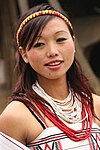Karbi people
[6] However, Karbis in other Indian states like Meghalaya, Mizoram and Nagaland are unable to identify themselves as belonging to the Scheduled Tribes, as the Constitution of India only recognises 'Mikir'.The original home of the various people speaking Tibeto-Burman languages was in western China near the Yang-Tee-Kiang and the Howang-ho rivers and from these places, they went down the courses of the Brahmaputra, the Chindwin, and the Irrawaddy and entered India and Burma.[10] The folklore of the Karbis, however, indicate that during the long past, once they used to live on the banks of the rivers the Kalang and the Kopili, along with Tiwas and Borahis, and the entire Kaziranga area, the famous National Park situated in Assam, was within their habitation.While a section of the Karbis remained in the Jaintia kingdom, others moved towards the north-east by crossing the river Barapani, a tributary of the Kopili and entered into the Rongkhang Ranges.The Karbis took refuge in the deep jungles and high hills leaving their hearth and home in the sub-mountainous regions.While some of the Karbis migrated to Western Assam, some had crossed the Brahmaputra and settled in the north bank which today encompasses the districts of Biswanath, Sonitpur and Lakhimpur.The practitioners of Animism believe in reincarnation and honor their ancestors even though with despite the significant Hindu religious plan and influence of the Vaishnavism variation.Ambika Tokbipi), Sat Sang (A reform of Hinduism founded by Thakur Anukul Chandra) and Honghari.They are Engti (Lijang), Terang (Hanjang), Enghee (Ejang), Teron (Kronjang) and Timung (Tungjang) which are again divided into many sub-clans such as Tisso, Rongpi, Bey and others.The traditional system of governance is headed by the Lindok, the king, who is assisted by the Katharpo, the Dilis, the Habes, and the Pinpos.It can be of different designs like jangre, santok, honki ranchom, marbong homkri, ahi cherop, chamburukso apini, mekserek etc.It has colourful fringes at both the length ends and can be found in designs like amekpi, amekso, abermung, thoithesuri angphar, suve arvo and phonglong angsu etc.Jiso is a long black cloth with designs and decorated fringes at the length end worn to cover the breasts.Sator is a white piece of cloth worn by men around the waist as the dhoti covering the whole length of the legs.A long pe seleng is also used as sator with colourful designs all over and borders at both the length end which covers up to the knee.Traditionally, a characteristic feature of a Karbi woman was her facial tattoo, dyed with indigo from the forehead down to the chin.They are quite self-sufficient and have homestead gardens with betel nut, jackfruit, oranges, pineapple, pear, peach, plum, etc.[citation needed] As of 2003, the district of Karbi Anglong has the highest HPI (Human Poverty Index) value of 33.52 within the entire state of Assam.
Naga woman
Karbi, ArmeniaKarbi AnglongArunachal PradeshMeghalayaMizoramNagalandBangladeshKarbi languageAmri languageAnimismHinduismChristianityTibeto-BurmanChin peopleKuki peopleDimasa peopleNaga peopleBamar peopleCulture of AssamHistoryPragjyotisha kingdomKamarupa kingdomDimasa–Kachari kingdomKamata KingdomSutiya kingdomBaro-BhuyanAhom kingdomSingarigharuthaColonial AssamAssam ProvincePeopleAssamese peoplesBrahminsChutiasKaibartasKalitasMuslimsRangpuriSylhetiScheduled tribesDeorisDimasasMisingsRabhasRajbongshisTea-tribesLanguagesAsamiyaKamarupi PrakritGoalpariya dialectsScriptHajongKachariGamosaHengdangKirtansNamgharsMekhela chadorSatrasfolkloreBirinchi Kumar BaruaChand SadagarGoalpariya LokogeetKamrupi LokgeetCuisineJudimaAli Ai LigangAmbubachi MelaDurga PujaMe-Dam-Me-PhiReligionEkasarana DharmaShaktismBathouismBuddhismJainismCultural development of KamarupaVrindavani vastraLiteratureKotha RamayanaThe OrunodoiThe JonakiThe HemkoshPoetryFolk literatureAssam Sahitya SabhaAssam RatnaAssam Sahitya Sabha AwardAssam Valley Literary AwardKamal Kumari Foundation AwardKrishnakanta Handique AwardFolk dancesGuwahati Theatre FestivalKohinoor TheatreCinemaBrahmaputra Valley Film FestivalFilmfare Awards EastGauhati Cine ClubJoymotiNational Film Award for Best Feature Film in AssameseTamreswari TempleSymbolsCoat of armsO Mur Apunar DeshDr. Bhupen Hazarika Regional Government Film and Television InstituteSadou Asom Lekhika Samaroh SamitiNortheast IndiaWest Karbi AnglongKarbi Anglong districtWest Karbi Anglong districtDima HasaoKamrupMorigaonNagaonGolaghatKarimganjLakhimpurSonitpurBiswanath CharialiPapumpareJaintia HillsRi BhoiEast Khasi HillsWest Khasi HillsDimapur DistrictSylhet